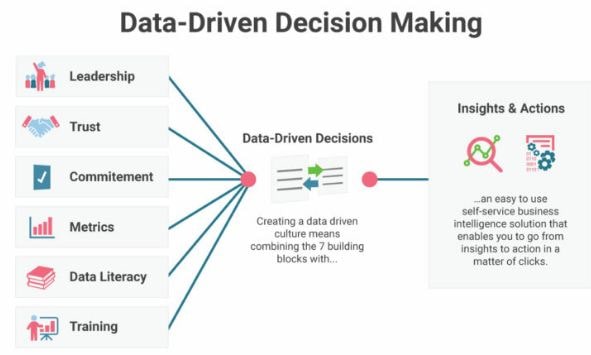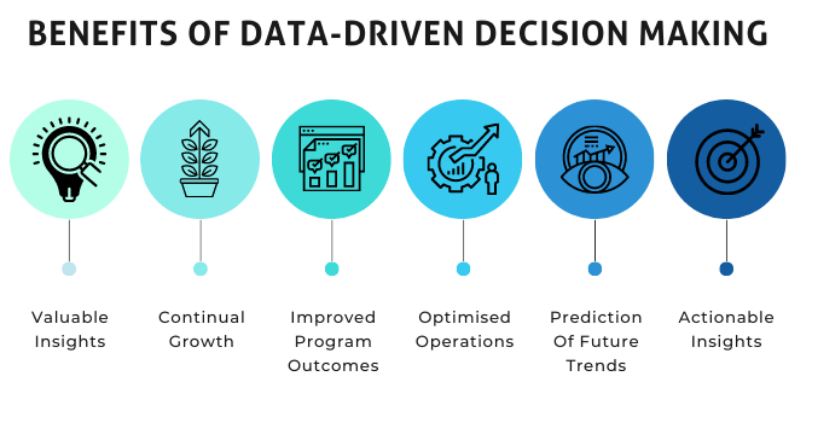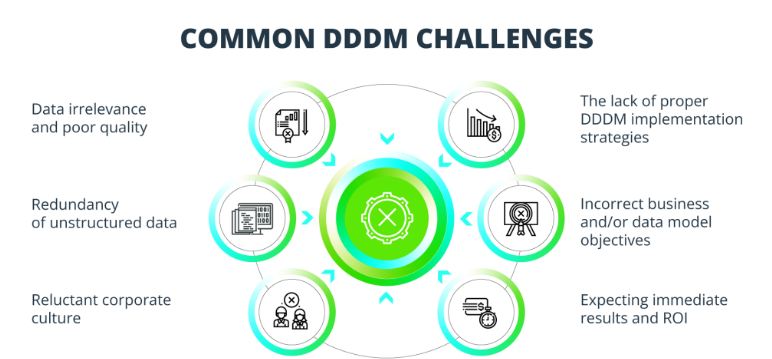Data-Driven Decision Making & Its Importance
Table of Contents
Today Companies that make decisions based on this data gain many competitive advantages, reduce business costs, and increase their profits; but how? In this article, we talk about data-driven decision making, explain its application and tell how it affects your business?
What is Data-Driven Decision Making?
Data-driven decision making (DDDM) means using facts, metrics, and data to drive strategic business decisions that align with your goals and initiatives. Your organization should make data-driven decision making the norm to create a culture that encourages critical thinking and curiosity.

In DDDM, past data is used to analyze trends and make decisions for the future, instead of making decisions based on feelings, opinions, or personal experience. Decisions are made based on past data. Companies using DDDM put data at the core of their work and decisions.
Importance Of Data-Driven Decision Making?
The basic premise of data-driven decision making is that the better and more comprehensive data can be collected, the better decisions can be made based on it. If there is no observation and data, people will simply make decisions based on their previous beliefs and cognitive biases.
In the words of the famous American engineer Edward Deming, “Without data, you are just a person with a personal opinion”.
For example, imagine you are planning a marketing strategy for a SaaS company. Instead of starting from scratch and hoping your new strategy will work, take a look at your previous introductions. Have they had a good result? If the answer is yes, repeat it. Never repeat something that did not have a good result.
Simply put, repeat effective tasks and don’t repeat ineffective ones. All of this is based on the data you have collected to make an intelligent decision.
Five Steps in Data-Driven Decision Making
An Economist study found that businesses that use DDDM perform better and are more profitable than those that don’t. Here is the list of five basic steps to implement data-driven decision making.
- Determine the business questions or problems
What does the company want to do? Identify the most important areas to achieve its overall strategy. Does the company want to evaluate an opportunity or identify a problem?
- Strategize and identify goals
Having a clear analytical objective is essential. Who will oversee the collection and analysis? What personnel will you need for the project? Can employees do the analysis in-house, or do you hire consultants?
- Target data
Determine what data should be collected and how you should obtain it. What specific data is needed to answer the main questions?
- Data collection and analysis
You must have processes and personnel in place to collect and manage data. Data can be generated from various sources such as computer software, online sources, cameras and imaging systems, environmental or personnel sources.
Once the data is collected, it should be analyzed to gain strategic insights. Common types of analytical methods include text, speech, and video/image analysis. You can easily use the Ingro platform for big data analysis.
- Decide on the findings
Data-driven decision makers can turn analytical insights into actionable ideas and projects.
Importance of Data-Driven Decision Making in Business
The benefits of data-driven decision making have become apparent to everyone. Companies use data in a decision making showed that the more data-driven a company is, the more productive it is. Even considering a wide range of intervening variables, such a result is obtained.
A higher standard deviation in the designed index means four to six percent more productivity. The same study showed that data-driven decision-making has a positive correlation with asset return rate, stock return, asset utilization, and market value, and this relationship appears to be causal.
Another report showed that in 2014, every dollar spent on data analysis had an average return on investment of $13.01. This ratio was 10.66 dollars in 2011.
What business decisions should we make using this data?
Once you know how you can benefit from data-driven decision making, you need to take the next step. This means identifying how you can leverage data to grow your business.
For example, you may use data to:
Finance
What is the most cost-effective way to hire new employees or the cheapest way to promote a new product?
Growth
What activities can help prevent losses? How can you attract more loyal customers? Are the new features you’re working on impacting your business goals?
Marketing and Sales
Which Advertising Channel Gets the Best Feedback and Results? Which activities attract the most customers?
Customer Service
What is the most cost-effective way to handle support messages? Which channel improves response time?
Benefits of Data-Driven Decision Making
Once you start collecting and analyzing data, you’ll likely find it easier to make decisions about almost any business challenge. Whether you’re deciding to launch a product, stop production, adjust your marketing message, or Enter a new market and data fulfills several roles.
- You will act more dynamically
When you first implement a data-driven decision-making process, you will likely encounter an inflexible nature. Data tells a story, then you and your organization must react to it.

- You can save money
One of the most effective ways to use data is to reduce costs. Of the organizations that have used data-driven decisions in their projects to reduce costs, more than 49%.
Common Challenges of Data-Driven Decision Making
Data-driven decisions are easier said than done. Relying on your data to make better decisions comes with its own set of challenges. Failure to identify and plan for or overcome these challenges can jeopardize your data-driven decision-making efforts.
- Lack of infrastructure and tools
Actually collecting data can be a challenge because you need to have the right infrastructure and tools. Many businesses implement CRM to collect and organize their customer data in one centralized location.
- Poor quality data
One of the biggest challenges of collecting information is the poor quality of the data. Things like duplication, inaccuracies, inconsistencies, and incompleteness can all affect the quality of your data.

- Lack of organization on a large scale
Make sure everyone in your organization is on board with data-driven decision-making, especially when it comes to key employees. Likewise, ensuring that all data is in one place is critical to impacting your ability to collect and analyze accurate data.
- Confusion about how data is used
Even if you collect accurate data, another issue that may arise is actually knowing how to use the data to help make data-driven decisions. Not knowing what to do with the data you have?
- Inability to identify practical data
Deciding to track and analyze data means deciphering data that is actionable in the long term. You can’t make data-driven decisions if you’re collecting and analyzing data that doesn’t apply to the main decisions you need to make in the future.
- Too much focus on data
Although data can help you make more informed decisions, it’s best not to over-rely on your data. There are cases where you need a human element to make better decisions. In such cases, focusing only on data can be limiting. A balance between data and creativity is necessary to achieve the best possible results.
FAQs
Q1:- What is an example of data-driven decision making?
Ans: E-commerce sites usually use data to increase profits and sales. If you’ve ever shopped on Amazon, you’ve probably received a product recommendation when visiting Amazon’s website or via email. This is an example of a data-driven business decision.
Q2:- What is the importance of data-driven decisions?
Ans: It forms the central part of the organization. Data-driven decision making is critical because it enables us to view data in real-time, real-time to gain predictive insights. It provides the ability to research and know what is good for business and what is not.
Q3:- What does data-based decision making include?
Ans: Data-driven decision making (DDDM) involves making decisions that are backed up by hard data, rather than decisions that are intuitive or based on observation. Data-driven decision making is also known as data-driven decision management or data-driven decision making.
Q4:- How do you use data-driven decisions?
Ans: Here’s a five-step process you can use to start making data-driven decisions. Look at your goals and prioritize. Every decision you make should start with the main purpose of your business.
- Find and present relevant data.
- Draw conclusions from that data.
- Plan your strategy.
- Measure success and repeat.
- Data-driven decisions.
Q5:- How do you promote data-driven decision making?
Ans: 5 ways to improve data-driven decision-making.
- Make data more accessible. In the fast-paced world of data and technology, flexibility and agility are more important than ever.
- Make data more interesting.
- Ensure data is more accessible.
- Make data more useful.
- Make data more agile.
Q6:- Why is data so important?
Ans: Data allows organizations to visualize the relationships between what is happening in different locations, departments, and systems . … looking at these data points together allows us to develop more accurate theories, and provide more effective solutions.
Q7:- How does data affect decision making?
Ans: Why is data-driven decision making important? The importance of data in decision making lies in stability and continuous growth. It enables companies to create new business opportunities, generate more revenue, predict future trends, optimize current operational efforts and generate actionable insights.
Q8:- What does it mean to be data-driven?
Ans: When a company uses a “data-driven” approach. It means that it makes strategic decisions based on the analysis and interpretation of data. A data-centric approach enables companies to examine and organize their data with the goal of better serving their customers and consumers.
Q9:- What are the benefits of decision making?
Ans: Pros of individual decision making are:
- A person usually makes quick decisions.
- People do not escape responsibility.
- Individual decision-making saves time, money, and energy because people generally make quick and rational decisions.
- Individual decisions are more focused and rational compared to a group.
Q10:- What is the importance of decision making?
Ans: Decision making is perhaps the most important part of a manager’s activities . It plays the most important role in the planning process. When managers plan, they decide about many things, including what goals their organization will pursue, what resources they will use, and who will do each task.
Q11:- What companies use data-driven decisions?
Ans: Here are examples of how three companies Google, Amazon, and Southwest Airlines are using decision making to increase their success and profitability. The name Google is synonymous with data-driven decision making. The company aims to ensure that all decisions are based on data and analysis.
Q12:- What are the different types of data?
Ans: 4 types of data: nominal, sequential, discrete, and continuous. These are usually extracted from audio, image, or text media.
Q13:- How to make data-driven decisions
A well-rounded data analyst knows the business well. He Identifies data sources. Put together the sources from which you will draw your data. Perform statistical analysis. And make a Conclusion.
Q14:- What is the difference between data-driven decision making and data intelligence?
Ans: If you are data-driven, you have the exact data you need to make decisions. Data intelligence means everyone is aware of current performance and why the product is performing the way it is to optimize your strategies.
Q15:- How would you describe a data-driven person?
Ans: In a data-driven business, people are empowered to solve problems with as much data as possible . … Data-driven people don’t need to be top statistics or technology experts, but they have a good attitude about analytics and know how to get good at finding the truth.
Q16:- What are data-driven techniques?
Ans: A data-driven approach is when decisions are based on the analysis and interpretation of hard data rather than observation. A data-driven approach ensures that solutions and plans are supported by a body of real information, not just speculation, emotion, and anecdotal evidence.
Q17:- How does data analysis help decision making?
Ans: Data analysis plays an essential role in the entire regulation. This allows a business to predict the scope of its actions to the extent that it can determine its effectiveness without having to dive into it.
Q18:- How does data analysis support decision making?
Ans: Data analysis plays a vital role within a company by providing insight into decision-making based on improving efficiency. Using Insights provides unique insight into complex internal business scenarios. Businesses can use analytics to improve their profit margins by developing more efficient processes.
Q19:- How do information systems help in decision making?
Ans: The main purpose of information systems is to help decision makers by providing accurate and time-based information and helping to make correct decisions in turbulent environments. Management information systems help solve both structured and unstructured problem environments.
Q20:- What is the data collection method?
Ans: Data can be grouped into four main types based on collection methods: observational, experimental, simulation, and derived.
Q21:- Why is data collection so important?
Ans: Why is data collection so important? Data collection allows you to store and analyze important information about your current and potential customers. Unlike face-to-face data collection, digital data collection allows for much larger sample sizes and improves data reliability.
Q22:- What is data decision making?
Ans: Data-driven decision making (DDDM) is defined as the use of facts, metrics, and data to guide strategic business decisions that align with your goals, objectives, and initiatives. Your organization should make data-driven decision making. The norm creating a culture that encourages critical thinking and curiosity.
Q23:- How to approach data-driven decisions in education?
Ans:
- Collect high quality raw data. …
- Perform analysis that ensures results are relevant and diagnostic. …
- Use relevant and diagnostic data to inform training and operational decisions. …
- Key organizational supports
- Data infrastructure…
- Analytical capacity
Conclusion
There is no doubt that data is a valuable tool for any business. Companies that use data to make decisions reduce costs and increase profits. It is better to use data to prove that your decisions will have a positive impact on the growth of your business.
This development is worth analyzing past data. The next time you need to make a decision, rely on the data you have. This is the technique you need to thrive, compete, and gain a loyal customers.
Final Words
Hope you understand the topic completely. If you still have any questions write us in the comment section. we will answer you very soon. Do share with your friends if you like this. Thanks.


